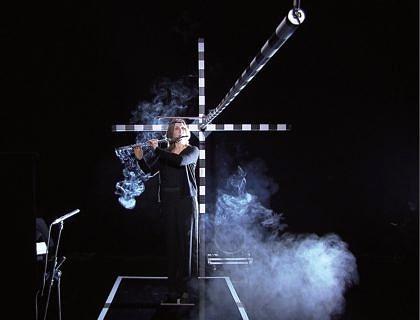Results of aerosol study conducted with the Bavarian Radio Symphony Orchestra

Researchers from Universitätsklinikum Erlangen and LMU Klinikum Munich investigated the distribution of aerosols while musicians played the trumpet, flute and clarinet
Further results are now available from the complex study conducted by Universitätsklinikum Erlangen, LMU Klinikum München and Bayerischen Rundfunk (BR) with members of the Bavarian Radio Choir about the risk of infection from coronavirus while singing, which generated a lot of interest when it was first published. The further analysis of the data involved investigating the spread of aerosols and therefore also the potential for viruses to spread while playing wind instruments, with the help of members of the Bavarian Radio Symphony Orchestra (BRSO). The results indicate that the distance either side of players in an orchestra could be reduced to below what is currently recommended. The study was funded by the Bavarian State Ministry of Education and the Arts.
State minister Bernd Sibler emphasised: ‘One of my main tasks as Minister for the Arts is to enable cultural events to take place. It is especially important to protect the health of musicians and the audience during this pandemic. The more we know about coronavirus, the more we can finetune our measures to ensure it’s safe for musicians to work. As I am also Minister for Science, I wholeheartedly support the work of our scientists as it forms the basis for making responsible decisions. I would like to thank all those who are working on this study and providing new prospects for reopening cultural institutions.’
Making aerosols visible with substances from electronic cigarettes
In contrast to other studies where the absolute aerosol concentration was measured when playing an instrument, this study focused on determining the acute spread and distribution of aerosols in the room when certain wind instruments were played. PD Dr. Stefan Kniesburges, a fluid mechanics specialist at the Department of Otorhinolaryngology – Head and Neck Surgery at Universitätsklinikum Erlangen, and Prof. Dr. Matthias Echternach, Head of the Department of Phoniatrics and Paediatric Audiology at LMU Klinikum München, installed a test setup in a BR studio in Unterföhring which made it possible to observe and measure the distribution of aerosols while a wind instrument was being played after they were inhaled using the base substance of electronic cigarettes.
Recommended distances in front and to the side
The analysis of the measurements of the clouds of aerosols revealed that the distance between members of the orchestra and their colleagues in front of them should be greater than to those to either side of them. This is under the condition that the room is permanently ventilated, and therefore that the aerosols are being regularly replaced by fresh air. ‘The wind instruments used in the study have different dispersion patterns to the front. The average length of the cloud of aerosols from the mouthpiece of the trumpet and clarinet was 0.9 metres. Some musicians achieved lengths of 1.5 metres, which means it would be advisable to increase the distance between musicians to 2 metres. However, we measured distances of up to 2 metres from the mouthpiece to the front for the flute, which means a distance of 2 metres is too low and a distance of 3 metres seems more appropriate in this case. The distance achieved by the aerosols emitted either side of all musicians in the study was less than one metre. A distance of 1.5 metres seems sufficient here in contrast to the recommended distance of 2 metres,’ explains Matthias Echternach.
‘Our data only refers to the direct distribution when musicians are actually playing. For the safety of the musicians, however, it is vital that the aerosols are permanently removed from the room so that they do not accumulate,’ adds Stefan Kniesburges. The lead investigators agree that the extent to which aerosols can be removed under realistic conditions on stage and during rehearsals is not yet understood in detail. ‘Further studies are required in terms of the conditions during rehearsals and performances to investigate any additional measures and their potential to reduce risk and their effects on acoustics.’
Reducing distance between players will enable larger concert repertoire
‘This extremely detailed study provides important insights about safe distances between musicians on stage. We hope that the results will quickly be incorporated into the guidelines for decision makers,’ says Nikolaus Pont, manager of the Bavarian Radio Symphony Orchestra. ‘Even reducing the distance either side of players of wind instruments would enable us to expand our repertoire on stage again.’
Christopher Corbett, solo clarinettist at the BRSO adds: ‘It’s essential for us as musicians that we can hear each other while we are playing. It would be extremely helpful if the distance between players in a row in the various instrument sections could be reduced. It would make it easier to communicate with our fellow musicians on a musical and emotional level, and the audience can hear the difference.’
Source: LMU Klinikum, Communications and Media Office
Further information
PD Dr. Stefan Kniesburges
Phone: +49 9131 8532616
E-mail: stefan.kniesburges@uk-erlangen.de
Prof. Dr. Matthias Braun
Phone:+49 89 4400-73861
E-mail: matthias.echternach@med.uni-muenchen.de